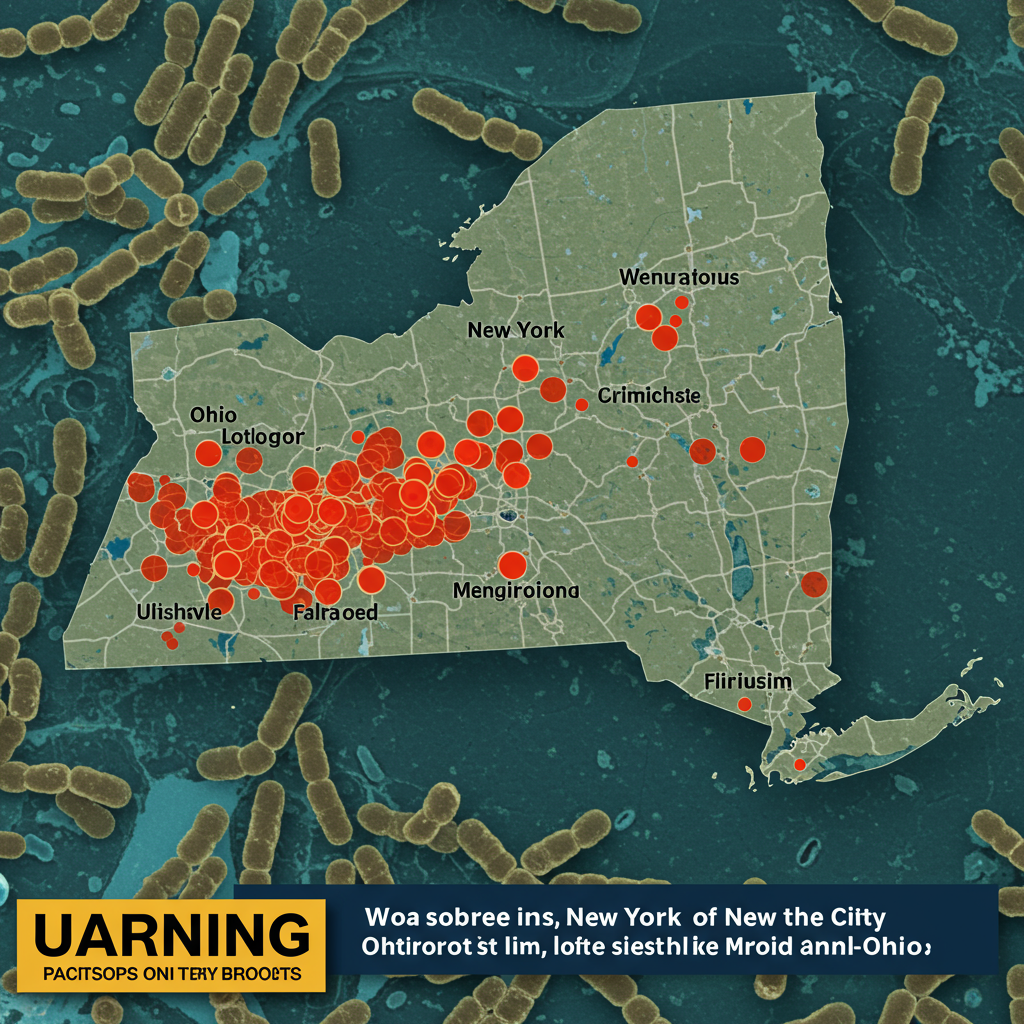Recent headlines reveal a concerning surge in Legionnaires’ disease cases across various regions, including a significant outbreak in New York City and increasing numbers in places like Ohio. This severe form of pneumonia, caused by Legionella bacteria, demands public attention. Understanding how it spreads, its symptoms, and effective prevention strategies is crucial for public health. This comprehensive guide synthesizes expert insights and the latest outbreak details to equip you with vital information, helping you protect yourself and your community.
Understanding Legionnaires’ Disease: More Than Just a Bad Cough
Legionnaires’ disease is a serious lung infection, a specific type of pneumonia, caused by the Legionella bacterium. While often grouped under the broader term “Legionellosis,” it’s distinct from the milder, flu-like illness known as Pontiac Fever, though both originate from the same bacterial culprit. Untreated, Legionnaires’ disease can be life-threatening, making early detection and appropriate medical intervention critically important.
The Legionella bacteria naturally occur in fresh water environments like lakes, streams, and soil. However, the real danger emerges when these bacteria proliferate in man-made water systems, especially those designed to store or move water. These systems, if not properly maintained, create ideal conditions for Legionella to multiply to hazardous levels.
How Legionnaires’ Disease Spreads
Unlike common colds or the flu, Legionnaires’ disease is generally not spread from person to person. You contract the illness by inhaling tiny water droplets, or aerosols, contaminated with the Legionella bacteria. Imagine walking past an air conditioning unit that’s releasing a fine mist, or using a showerhead in a contaminated system – these are common scenarios for exposure.
Key sources where Legionella can thrive and become aerosolized include:
Cooling Towers: These large structures on building rooftops are designed to cool water for air conditioning systems. If not regularly cleaned and disinfected, they can become breeding grounds for the bacteria, dispersing contaminated mist over a wide area.
Hot Tubs and Spas: Warm, stagnant water, especially without proper disinfectant levels, is an ideal environment for Legionella growth.
Showerheads and Sink Faucets: In large or complex plumbing systems, particularly in hotels, hospitals, or long-term care facilities, the bacteria can colonize pipes.
Decorative Fountains and Water Features: Outdoor and indoor fountains that create mist can also pose a risk if contaminated.
Large, Complex Plumbing Systems: These systems can provide ample space for biofilm (a protective slime layer) to form, shielding Legionella from disinfectants.
The conditions that foster Legionella growth in water systems are specific. These include water temperatures between 77 and 113 degrees Fahrenheit (25-45°C), insufficient disinfectant levels, and slow or stagnant water movement.
Recent Outbreaks: A Global and Local Concern
News of Legionnaires’ disease outbreaks underscores the need for public vigilance. This summer, New York City, particularly Central Harlem, experienced a significant outbreak. This cluster sadly led to six deaths and sickened over 100 residents, with at least seven individuals requiring hospitalization. Health officials rapidly identified the source: 12 cooling towers across 10 different buildings in the area. These implicated towers, including some on a hospital and a sexual health clinic, underwent immediate treatment, disinfection, or full remediation. Mayor Eric Adams reassured the public that the “air is safe to breathe” following swift public health actions. The affected ZIP codes included 10027, 10030, 10035, 10037, and 10039.
Beyond New York, a deadly outbreak also occurred in London, Ontario, resulting in four deaths and almost 90 hospitalizations. Nationally, the Cleveland Clinic estimates up to 18,000 people are hospitalized with Legionnaires’ disease annually in the U.S., with cases peaking between mid-summer and early fall, particularly from June to October. In Ohio, for example, the number of Legionellosis cases (encompassing both Legionnaires’ and Pontiac Fever) is increasing annually, with 311 cases recorded by late July 2025, showing an alarming 92% hospitalization rate. Health experts voice concern that as the planet warms, conditions may become even more favorable for Legionella to multiply, potentially leading to more frequent outbreaks.
Recognizing the Signs: Symptoms of Legionnaires’ Disease
Symptoms of Legionnaires’ disease typically manifest between 2 to 14 days after exposure to the bacteria. Initially, they often mimic common flu symptoms, making early diagnosis challenging. However, if these symptoms persist or worsen, medical attention is crucial.
Common symptoms can include:
Cough: This can range from dry to productive (bringing up phlegm).
Fever and Chills: A high fever is a frequent indicator.
Shortness of Breath: This is a hallmark of pneumonia, indicating lung involvement.
Headaches and Muscle Aches: General body discomfort and pain are common.
Gastrointestinal Issues: Some patients may experience nausea, vomiting, or diarrhea.
Confusion: In more severe cases, neurological symptoms like confusion can occur.
The World Health Organization (WHO) warns that if left untreated, Legionnaires’ disease usually worsens during the first week. Potential severe complications include respiratory failure, shock, and kidney or multi-organ failure. Therefore, vigilance and prompt medical consultation are paramount.
Who Is at Highest Risk? Understanding Vulnerable Populations
While most healthy individuals exposed to Legionella bacteria do not develop the disease, certain groups are at a significantly higher risk of falling ill. These vulnerable populations need to be especially cautious and aware of the symptoms.
High-risk individuals include:
Older Adults: People aged 50 and older are more susceptible.
Current or Former Smokers: Smoking damages the lungs, making them more vulnerable to infection.
Individuals with Chronic Lung Disease: Conditions like emphysema, COPD, or asthma increase risk.
People with Weakened Immune Systems: This includes individuals with HIV/AIDS, cancer, or those taking immunosuppressant drugs (e.g., after an organ transplant).
Those with Underlying Health Conditions: Diabetes, kidney failure, or liver failure can also increase susceptibility.
Hospitalized Patients: Especially those in intensive care or with respiratory illnesses, can be exposed through contaminated hospital water systems.
Residents of Long-Term Care Facilities: These environments often have complex plumbing systems and a population with multiple risk factors.
Even for people walking around their neighborhoods, exposure can occur from breathing in contaminated air without knowing it. The key is understanding that while exposure might be common, developing the disease is less so for healthy individuals.
Diagnosis and Effective Treatment
If Legionnaires’ disease is suspected, rapid diagnosis and treatment are critical for a positive outcome. A chest X-ray can confirm pneumonia, but specific tests are needed to identify Legionella as the cause. These include:
Urine Test: A common and quick method.
Laboratory Swab Tests: Analyzing phlegm (sputum) or lung lavage samples.
Once diagnosed, Legionnaires’ disease is treatable with antibiotics. However, it’s important to note that the most common antibiotics used for other types of pneumonia are often ineffective against Legionella. Specific antibiotics are required, making community awareness crucial for correct treatment. As health experts confirm, “It’s well known in the medical community what to do, but I also feel that patients need to understand that.” Hospital care is often necessary due to the severity of the infection.
Protecting Yourself: Essential Prevention Strategies
Preventing Legionnaires’ disease involves a multi-pronged approach, ranging from large-scale building management to individual actions at home.
For Building Owners and Managers
The Centers for Disease Control and Prevention (CDC) strongly advises building owners and managers to implement comprehensive water management programs. These programs are designed to control the growth and spread of Legionella bacteria within their water systems. Key measures include:
Regular Cleaning and Disinfection: Especially for cooling towers, hot tubs, and decorative fountains.
Maintaining Adequate Disinfectant Levels: Ensuring proper chlorine levels in spa pools and other water features.
Monitoring Water Temperature: Keeping water temperatures outside the Legionella growth range (77-113°F) where possible.
Preventing Water Stagnation: Regularly flushing unused taps and ensuring water circulation.
For Homeowners and Individuals
While most outbreaks are linked to large building systems, you can also take steps to minimize risk in your own home:
Flush Unused Faucets: If a showerhead or faucet hasn’t been used for a while (e.g., after returning from vacation), let the water run for a few minutes before use.
Maintain Hot Water Heaters: Flush your hot water heater twice annually according to manufacturer instructions.
Clean Water-Using Devices: Regularly clean and descale showerheads, aerators, and humidifiers. Adhere strictly to manufacturers’ instructions for cleaning and replacing filters in these devices.
Hot Tubs and Pools: Consistently check and maintain appropriate chlorine levels in your pools and hot tubs.
Garden Hoses: Drain garden hoses after use and store them properly.
General Public Awareness and Action
Staying informed and being proactive are your best defenses.
Be Aware of Symptoms: If you develop a fever, persistent cough, or shortness of breath for more than a day or two, especially if you fall into a high-risk group or live in an outbreak area, seek medical attention immediately. Be sure to mention any potential exposure or concerns about Legionnaires’ disease to your doctor.
Consider Masking: While there’s no general recommendation for the public to mask, individuals at higher risk (older adults, immunocompromised) might consider wearing a respirator mask (like a KN95 or N95) in areas with known outbreaks, particularly if outdoors. This can offer a layer of protection against inhaling aerosolized bacteria.
Stay Hydrated and Practice Good Hygiene: These general health practices support overall well-being.
Prompt medical attention is vital if symptoms appear. Early medical intervention with specific antibiotics significantly improves outcomes and helps prevent severe complications.
Frequently Asked Questions
What causes Legionnaires’ disease and how does it spread?
Legionnaires’ disease is a severe form of pneumonia caused by the Legionella bacteria. These bacteria naturally live in freshwater environments but become dangerous when they proliferate in man-made water systems like cooling towers, hot tubs, and large plumbing systems. The disease spreads when individuals inhale tiny water droplets, or aerosols, contaminated with the bacteria. It is important to note that Legionnaires’ disease is not typically transmitted from person to person, unlike common respiratory illnesses.
What immediate steps should I take if I suspect Legionnaires’ disease, especially if I’m in a high-risk group or an outbreak area?
If you develop flu-like symptoms such as a persistent cough, fever, muscle aches, headaches, or shortness of breath, particularly if you are aged 50 or older, a smoker, or have a weakened immune system and live in an area with a known outbreak (like Central Harlem, NYC), you should seek immediate medical attention. Inform your healthcare provider about your symptoms and any potential exposure, asking for appropriate testing for Legionella detection. Early diagnosis and specific antibiotic treatment are crucial for recovery.
How can I prevent Legionnaires’ disease at home and what measures are building owners taking?
At home, you can reduce risk by regularly cleaning and descaling showerheads, flushing unused faucets for a few minutes, maintaining proper chlorine levels in pools/hot tubs, and flushing your hot water heater twice annually. For building owners and managers, prevention involves implementing comprehensive water management programs, as recommended by the CDC. These programs focus on regular cleaning and disinfection of cooling towers, maintaining optimal water temperatures, and ensuring adequate disinfectant levels in water systems to control Legionella growth.
Staying Vigilant for a Safer Community
Legionnaires’ disease, while concerning, is manageable with proper awareness, prevention, and prompt medical care. The recent outbreaks in New York City and London, along with rising national case numbers, serve as a potent reminder of its potential impact. By understanding the sources of Legionella, recognizing the symptoms, and implementing effective prevention strategies—both individually and at a community level—we can significantly reduce the risk. Stay informed, listen to public health advisories, and never hesitate to seek medical attention if you experience concerning symptoms. Your proactive approach is key to protecting yourself and contributing to a healthier community.



